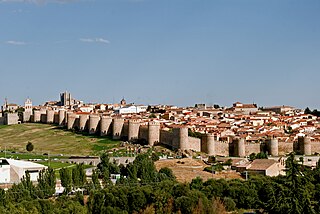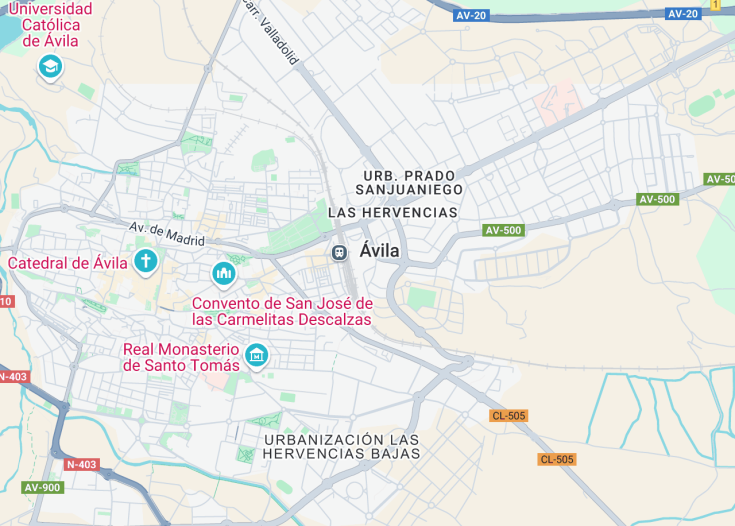Avila, a historic city set in the rolling hills of the Castile and Leon region in Spain, is renowned for its perfectly preserved medieval walls. Founded in the 11th century to protect the Spanish territories from the Moors, Avila is a testament to ancient military architecture, featuring 88 towers and nine gates. The city is also famous for being the birthplace of Saint Teresa, contributing significantly to its spiritual and cultural heritage. Visitors are captivated not only by its monumental history but also by its vibrant cultural scene, hosting numerous festivals and events throughout the year.
When visiting Avila, ensure to walk atop the city walls for a breathtaking panorama of the city and the surrounding countryside. It’s an unparalleled view that captures the essence of Avila’s historical grandeur.
Planning a trip to Avila, try to coincide with one of its many festivals, such as ‘Las Fiestas de Santa Teresa’, to experience the local culture and traditions at their peak.
Top things to do & see in Avila
Select the following sights and activities to discover best tickets and tours available in Avila.
Avila: A Journey through Time
| Country | Spain |
| Time in Avila | GMT+1 |
| Language spoken | Spanish |
| Population | 57,744 (INE 2021) |
| Currency | Euro (€, EUR) |
| Airports |
|
Avila, one of Spain’s most historic cities, is renowned for its perfectly preserved medieval city walls. Located in the autonomous community of Castile and León, this city offers a vivid picture of Spain’s grand past. Avila’s old town, together with its churches and convents, forms a UNESCO World Heritage Site that attracts historians and tourists alike. One cannot discuss Avila without mentioning Santa Teresa, the revered mystic saint born here in 1515. The city honors her with multiple monuments and a dedicated museum.
Steeped in religious and military history, Avila’s walls, which date back to the 11th century, stand as a testament to its strategic importance. These imposing stone barriers, complete with 88 watchtowers and nine gates, encircle the city, showcasing excellent Romanesque and Gothic architecture. Visitors often walk alongside the walls, enjoying panoramic views of the city and the surrounding landscape of Castile and León.
In addition to its rich history, Avila’s gastronomy offers an authentic taste of Spanish cuisine, with specialties such as ‘Yemas de Santa Teresa’ (a sweet treat made from egg yolk) and ‘Chuletón de Ávila’ (a succulent beef steak). Seasonal festivals further enrich the cultural canvas of the city, blending traditional dances, music, and medieval markets.
Where is Avila?
Avila is situated in the heart of Spain, northwest of Madrid.
Distances:
| Route | Distance by car | Time by car |
|---|---|---|
| Madrid to Avila | 88 miles | 1 hour 30 minutes |
| Salamanca to Avila | 60 miles | 1 hour 10 minutes |
| Valladolid to Avila | 78 miles | 1 hour 20 minutes |
What is Avila famous for?
Avila is famous for its well-preserved medieval city walls, historic churches, and being the birthplace of Saint Teresa of Jesus, one of the foremost mystic saints.
History
Pre-Roman Times to Middle Ages (Before 11th Century)
The area of Avila, located in the heart of Spain, has been inhabited since prehistoric times, as evidenced by ancient relics found in the region. However, the city’s significant history began with its Roman conquest. Post the decline of the Roman Empire, Avila’s strategic importance grew under the Visigoths, only to face frequent Muslim invasions in the Middle Ages. Its true renaissance came with the Reconquista when Christian forces began to fortify the city extensively.
Rise as a Fortified City (11th – 14th Century)
Avila’s golden age commenced in the 11th century when it was reconstructed as a fortified city. This period saw the construction of Avila’s iconic walls, still standing today. The walls, built to protect against Moorish invaders, feature 88 towers and 9 gates, making Avila a military stronghold. The city became a symbol of Christian might, and its architecture from this period reflects a blend of Romanesque and Gothic styles.
The Age of Enlightenment and War (15th – 18th Century)
By the 15th century, Avila transcended its military roots to become a hub for Renaissance and Enlightenment thinkers. However, the city’s progress fluctuated due to its involvement in various wars, including the War of Spanish Succession. Still, Avila maintained its cultural importance, with notable figures like Saint Teresa contributing to its spiritual and cultural heritage.
Modern Developments (19th Century to Present)
The industrial age brought railways and modern infrastructure to Avila, though it remained overshadowed by larger cities. Today, Avila is recognized as a UNESCO World Heritage Site, celebrated for its well-preserved medieval walls and historical buildings. The city has embraced tourism while preserving its rich history and cultural legacy, melding ancient heritage with modern comforts.
Visit Avila
What to see and do in Avila
Avila, a city steeped in history and culture, offers a multitude of attractions and activities for visitors. The city’s crown jewel, the Avila Walls, encircles the old town and provides breathtaking views of the surrounding countryside. Inside, the Cathedral of Avila, a masterpiece of Gothic architecture, houses a wealth of art and religious artifacts. For those interested in spiritual history, the Convent of Saint Teresa offers insights into the life of Saint Teresa of Avila, one of the city’s most revered figures.
- Tour the Avila Walls
- Visit the Cathedral of Avila
- Explore the Convent of Saint Teresa
- Stroll through the historic town center
- Try local culinary delights such as ‘Yemas de Santa Teresa’
Festivals and Events in Avila
Avila hosts a variety of cultural events throughout the year that celebrate its rich history and vibrant traditions. The most notable is ‘Las Fiestas de Santa Teresa’, celebrating the feast day of Saint Teresa in October, which features religious processions, traditional music, and dance. The ‘Medieval Market’, held in September, transforms the city into a bustling medieval town, with crafts, foods, and historical reenactments bringing the past to life.
Best time to visit Avila
The best time to visit Avila is during the spring (April to June) and fall (September to October). These months offer mild weather, perfect for exploring the city’s historic sites and participating in outdoor activities. Additionally, many of the city’s cultural events occur during these periods, providing an enriched experience of local customs and festivities.
Is Avila worth visiting?
Avila is undoubtedly worth visiting, especially for those who appreciate history, culture, and architecture. The city’s impressive medieval walls, historic churches, and monasteries offer a glimpse into Spain’s rich past, while cultural festivals and local cuisine provide a taste of its vibrant present. Visiting Avila is like stepping back in time, offering a unique, unforgettable experience that combines the charm of ancient traditions with the comforts of modernity.









